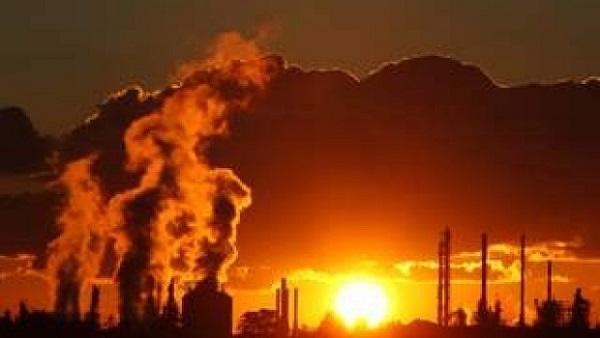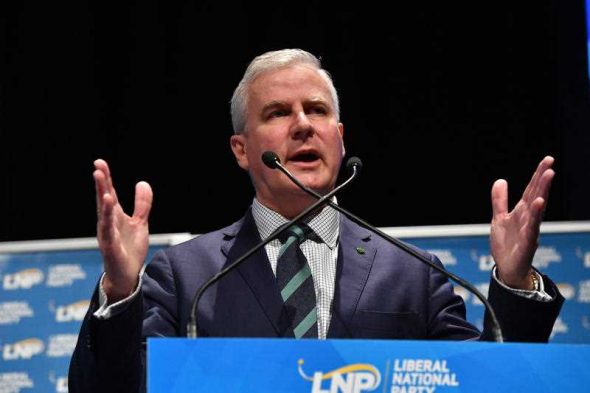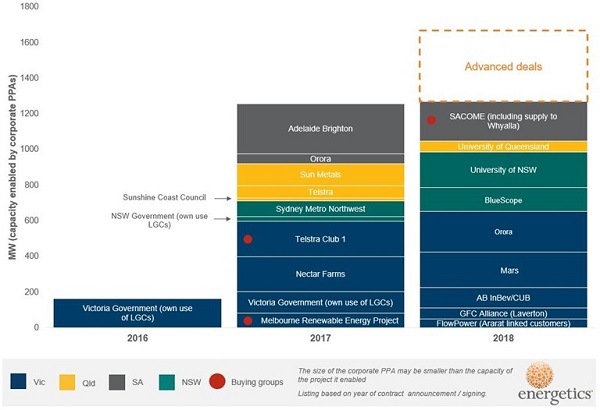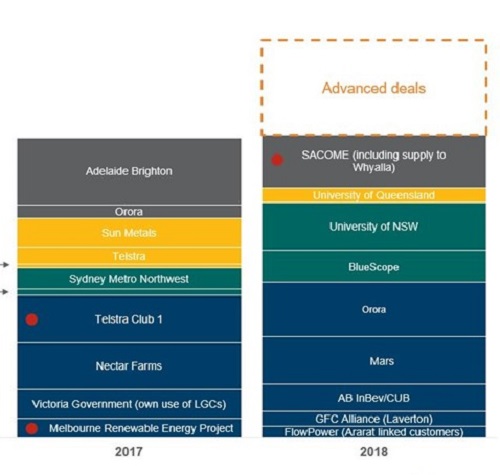 On the weekend Energy Minister Josh Frydenberg gently reminded the Coalsheviks in the LNP Coalition that they should not be flirting with the idea of coal-fired power, because
On the weekend Energy Minister Josh Frydenberg gently reminded the Coalsheviks in the LNP Coalition that they should not be flirting with the idea of coal-fired power, because
- we have to factor in a “carbon-constrained future”.
He warns that they may be investing in what will become ‘stranded assets’ before they wear out.
Why doesn’t he tell them like it really is? Tell them to look out the window.
The heatwave in Europe this year has been assessed as ‘five times’ more likely because of climate change. The northern summer’s heat is being recognised as the strongest climate signal yet. Wildfires have raced through neighborhoods in the western United States, Greece and as far north as the Arctic Circle. Drought is threatening food supplies:
- At sea, record and near-record warm oceans have sent soggy masses of air surging landward, fueling extreme rainfall and flooding in Japan and the eastern U.S. In Europe, the Baltic Sea is so warm that potentially toxic blue-green algae is spreading across its surface.
In Sweden the heat, apart from the wildfires, melted the county’s highest peak to the point where it is now second highest:
- According to Martin Hedberg, meteorologist at the Swedish Weather and Climate Center, “extreme heat is 100 times more common today than it was during the 1950s, ’60s and ’70s” globally.
Now:
- Penn State climate scientist Michael Mann said this summer’s extreme weather fits into a pattern he identified with other researchers in a study published last year. … “Our work last year shows that this sort of pattern … has become more common because of human-caused climate change, and in particular, amplified Arctic warming.”
Michael McCarthy at The Guardian asks Was this the heatwave that finally ended climate denial? Probably not. Perhaps if they look at Fire and water: July’s global weather extremes – in pictures they may be convinced.
Frankly, they’ll be run over by the future. A new MIT study has found that the most populous region of the biggest polluter on Earth – China’s northern plain – will become uninhabitable in places if climate change is not curbed:
- New scientific research shows that humid heatwaves that kill even healthy people within hours will strike the area repeatedly towards the end of the century thanks to climate change, unless there are heavy cuts in carbon emissions.
“This spot is going to be the hottest spot for deadly heatwaves in the future,” said Prof Elfatih Eltahir, at the Massachusetts Institute of Technology, US, who led the new study. The projections for China’s northern plain are particularly worrying because many of the region’s 400 million people are farmers and have little alternative to working outside.
That is where the Chinese produce much of their food.
Then if you tune into Richard Fidler’s conversation with architect Michael Kimmelman from 10:25 on The world’s sinking mega-cities they talk about three new Chinese cities of around 10 million each – Shenzhen, Dongguan and Guangzhou – producing much of the manufactured exports we use. This region is seriously threatened by sea level rise of a metre or less, having been built in the Pearl River Delta just north of Hong Kong.
I’ve checked the Firetree flood maps, and he’s right. There are nine municipalities there in all, representing 10% of China’s GDP.
Indeed, Yongqiang Zong of The University of Hong Kong found that an expected 30 cm rise in sea level by 2030 will pose a serious challenge to the local authorities. That was back in 2004.
I’ll call it now. If we take another seven years to build new coal-fired power, by 2030 they will be a stranded assets. I’ve chosen the image at the head of the post to symbolise the fact that the sun is setting on coal-fired power.
Electricity generation and distribution is a state responsibility. The reason why Commonwealth minister Josh Frydenberg is standing there on our TV sets talking as though the National Electricity Market (NEM) is his responsibility is because Tony Abbott committed us to fixing our share of the climate problem in the Paris Agreement, and Australia under Malcolm Turnbull signed up for it. NEM is run by COAG where the Commonwealth has one vote, but legislation to implement the emissions targets must pass the Commonwealth parliament. Or does it? Anthony Lynham has suggested regulation (see below).
As the Australian Government Department of Environment and Energy’s handsome document Powering forward: A better energy future for Australia produced in 2017 says, national policy is now faced with a trilemma – affordability, reliability and emissions. That order represents the priorities of the Commonwealth government.
The Energy Security Board (ESB) has now (on Wednesday 1 August) published the Final Detailed Design of the National Energy Guarantee for consideration by the COAG Energy Council on Friday 10 August.
Separately the ESB has published the Final Detailed Design – Commonwealth Elements which relate to national emissions reduction targets for the Paris Agreement, the treatment of emissions-
intensive trade-exposed (EITE) activities and the role of external offsets.
After 10 August, if agreement is reached by the states and territories, the whole bundle will be considered by the Coalition party room on August 14, where Craig Kelly warned “We are not rubber stamps.” Subsequently, if the Coalsheviks want changes, there will be a teleconference with the COAG Energy Council members to see whether they agree.
Upon agreement, the Commonwealth elements alone would be legislated by the Commonwealth government. NEM legislation is traditionally passed first in South Australia, and then implemented by application statutes in other jurisdictions.
All states and territories are represented on the COAG council, and all must agree. It operates on the basis of consensus, so every participant has a veto.
You can bet that Jay Weatherill would not have approved what has been served up, so the focus now falls on the Labor states, Queensland and Victoria, and the ACT.
ACT Climate Change Minister, Shane Rattenbury, is a Green. They are used to being the only one marching in step, or the only one singing in tune. Happens he has slammed the Federal Government’s national energy policy as “false advertising” and a “Frankenstein’s monster” of policies.
False advertising, because the plan will not do what it says it will.
- “Unfortunately in its current form, the NEG is largely false advertising, won’t achieve what it promises, and in fact it is likely to have a negative impact in all of the areas it claims to improve,” he said.
“One of the other ironies is that this policy is designed to deliver certainty and we can see that the low level of ambition that is built into it means there will not be certainty.
Lest you think Rattenbury is off on a frolic of his own, the ACT Legislative Assembly considered the issue on Thursday, and laid out its conditions for participation:
- In a debate in the ACT Legislative Assembly on Thursday, energy minister Shane Rattenbury (Greens), and chief minister Andrew Barr (Labor) said Australia needed to raise the ambition of the country’s emissions reduction target “right now.
And:
- “It must be possible to ramp up the target, to flexibly adjust, and ensure we are making adequate progress on cutting our emissions and preventing harmful climate change.”
The ACT is making a big point about how the state and territory emissions targets are being treated. The proposed NEG says that if some states do more than 26 per cent, other states can do less. ACT’s target is 100%. They have said there is no way they will allow New South Wales to freeload off their efforts.
The Labor states have suggested that the targets be implemented by regulation, rather than legislation.
- The federal government’s original plan was to enshrine the 26 per cent emissions cut – which most industry and academic energy experts say is inadequate – in legislation for a decade, and set the post-2030 target by 2025.
Now Frydenberg has offered a review in 2024, as Peter Hannan tells us in the SMH, “to ensure targets from 2025 to 2030 remain appropriate”. Too little too late, say the states. On the other hand an important part of the Commonwealth strategy is not to over-achieve the miserable 26% target. Effectively, the ‘Coalsheviks’ want to head renewable energy off at the pass.
Moving to regulation could be a good idea, taking the politics out of energy policy, which was the aim of the Gillard government setting up the Climate Change Authority. The LNP government first ignored the CCA when it found their recommendations uncomfortably ambitious, then nobbled the Authority by appointing new members.
Hannan tells us that the emissions target will be 97% achieved when the NEG starts in 2021. Giles Parkinson tells How Australia will get to 33% renewable electricity by 2020:
… it seems that Australia will end up with 33 per cent renewables by 2020, will likely get to 40 per cent by 2030, and has enough in the pipeline to reach 85 per cent.
These estimates were released by Green Energy Markets in their latest Renewable Energy Index, and analyst Tristan Edis points out that it means there is enough renewables being built to meet the targets of the proposed National Energy Guarantee, even before it is put in place.
Here’s a series of posts from RenewEconomy, belling the cat:
- Full absurdity of National Energy Guarantee laid bare
- NEG worse than thought – penalising rooftop solar and large-scale projects
- NEG: Commonwealth paper shows Coalition not budging on emissions
- Revealed: NEG “decisions” document confirms fears of critics
- NEG discriminates against rooftop solar, makes emissions task more expensive
- Conservatives entrench hard-line on energy after poll defeats
- David Leitch Why the ESB must release its agenda driven modelling
- Bruce Mountain ESB price claims for target already met are not credible
- Australia at 19% renewables – NEG 2030 target to be reached in 2021
- How Australia will get to 33% renewable electricity by 2020
- NEG may double carbon price to $35/tonne for industrial sectors
- Windlab urges “choose no NEG” if emissions target unchanged
- Big business lobby declares war on wind and solar
A lot of knowledge and brain power can be found in those posts, which, to sum up, say we’ve got a political fix, not a plan, based this time on Acil-Allen modelling which is suspect. Bruce Mountain, Director of the Victoria Energy Policy Centre at Victoria University, has called for the NEG modelling and the assumptions underlying the modelling to be made public.
Mountain, talking with Patricia Karvelis on Wednesday 25 July said the NEG policy was complex and difficult to understand. It places extra burdens and costs on retailers to achieve an outcome which will be achieved anyway, without the policy, so he can see no purpose for the policy, and can only see it increasing costs. He can’t see any basis for the policy reducing costs over what will happen anyway.
He has put his concerns into a paper which has been sent to all the relevant ministers. He says the promise to review the targets has no meaning, because if contained in legislation they can be reviewed at any time by a future government.
He says the NEG is a political fix for a non-problem, and the NEG won’t stop the unstoppable march to renewable energy.
In the Oz we are told Federal Labor blasts ‘pathetic’ NEG targets. That’s no doubt pay-walled, so here goes:
- Federal Labor has rejected Malcolm Turnbull’s national energy guarantee, declaring its “pathetic’’ emissions cuts will stifle renewable energy investment, threatening to extend a decade-long policy deadlock that has sent electricity prices soaring.
Look, it’s questionable whether the policy deadlock has sent prices soaring. Other reasons, such as the gold-plating of networks, the price of gas, and gouging by retailers have had more impact severally, let alone combined.
The Oz article does go on to talk about what Bruce Mountain thinks, and quotes the ABC on Labor:
- “Labor can’t agree to an arrangement that will tie the hands of future governments for at least a decade, arrangements that would see wholesale power prices higher than they should be, no cuts in pollution, and jobs and investment in this really important industry of renewable energy absolutely smashed,” Mr Butler told the ABC.
See also Mountain’s earlier articles:
- Three-wheeling towards a poor energy policy outcome
- Tesla battery + solar now “significantly cheaper” than grid power
Something needs to be said about energy security. To me it seems there is no problem about energy security, apart from ‘acts of God’ (that is, the weather) and excessively high energy security standards. Malcolm Turnbull in particular obsesses about this (from the Powering forward document):
- South Australia’s statewide blackout in 2016 and the February 2017 load-shedding events in New South Wales and South Australia were wake-up calls. They threw the spotlight on the energy challenges facing Australia with a greater reliance on intermittent sources of generation and a more decentralised grid.
He keeps making snide remarks about SA’s frolic with wind power, and we all how that ended. For a time, according to The Shovel, the Government was ‘Not Ruling Out’ GIANT FUCKING STORM As Cause Of SA Blackouts.
Seems the storm theory has disappeared in the mists of memory.
If SA’s power had been sourced from coal rather than wind, the power may have lasted a few seconds longer as 22 pylons hit the dirt. And in the cold start-up, wind came online before gas.
More particularly, however, fears about energy security seem to have penetrated the engineering arm of AEMO. In an article on 30 July (thanks to John D for the heads-up) Major solar, wind projects stumble in front of new grid hurdles we get this:
- Many new projects are being told that they face significant curtailment without either adding battery storage or old-style machinery known as synchronous condensers to deal with system strength issues.
Both options are causing headaches for developers, because either way they are trashing their financial models, and could cause extensive delays to projects that many expected would begin construction anytime soon.
The issue was highlighted in our story in May about the threat of curtailment in Victoria, where project developers were warned by the Australian Energy Market Operator that up to 50 per cent of their output was at risk of being wound back.
I’m not an engineer, and being of simple mind, wonder why this wasn’t a problem in SA which at times reached more than 50% penetration before a dirty big storm knocked down the power lines. In any case, those in the business are seeing this issue as bigger than whether we have an NEG or not.
I can put forward the opinion that such issues which run across distribution and generation could have been more rationally solved back in the days when electricity was run by state commissions.
Finally, two more pieces of information.
Firstly, as Giles Parkinson reports:
- The Liberal National Party in Queensland – one of the key battlegrounds in the next federal election – has effectively turned its back on renewable energy technologies and emissions reductions, and called for new coal fired power stations to be built in the state.
- “We are very pro-coal in the LNP. Of course we are,” Michael McCormack, the federal leader of the Nationals said when addressing the conference over the weekend.
Here he is:

Remember, New Deputy PM is a climate denier.
Secondly, there was a piece in Friday’s AFR – Corporate renewable energy deals exceed Hazelwood’s capacity.
Last year1200 MW of renewable capacity had been created directly to serve the needs of corporates in contracts to purchase renewable power, for example Sun Metals. Already this year, with Bluescope and others we’ve chalked up more than that, with another 400 MW of “highly advanced” deals in the pipeline, ignored by Acil-Allen in their modelling, for reasons best known to them.
The AFR got the information from Energetics, where we find this graph:

Here’s a cropped version showing last year and this:

The 2018 stack almost equates with Hazelwood – 1800 MW. A similar image was published in the AFR article.
It seems that renewables are indeed unstoppable on our rooftops and supplying directly to business, although the AEMO engineers have me worried. If the supply to business is not cheek by jowl the transmission lines and AEMO approval come into play.
My best guess is that the COAG ministers will kick the can down the road.
Update: See also NEG becomes a farce.

Oh dear, that was bigger than Ben Hur. Going to take a breather.
Gotta admire the honesty of the shovel.
It’s just, Jump, on this occasion they made a point.
Thanks a lot for your efforts, Brian.
Fear of being caught out with the world’s worst Stranded Assets will not deter anyone from investing in coal or keeping their investments in coal. Such fear would cause rational investors to worry – but we are not dealing with rational investors – we are dealing with irrational investors such as were seen in the South Sea Bubble or the Tulip Craze. For them, the physical laws of the universe, market realities and other awkward impediments are suspended. They have an overwhelming sense of entitlement because they are deserving or clever or rich – or all three. It is a waste of time trying to bring them to their senses; to do so would be like trying to plough the sea.
There is a lot of support for coal mining in Central Queensland. Not because the effects of climate change are unrecognized but simply because coal mining is the ONLY reliable source of work and pay around anywhere in the semi-state, especially for land-holders. Half the rural properties would be in the hands of the banks and other creditors tomorrow if coal mining and export stopped today. There is a Third World lack of jobs diversity throughout Central Queensland – so any enthusiasm for coal mining is quite understandable; as the saying goes, “Never argue with your bread-and-butter”.
Graham, I can understand and sympathise with the people of Central Queensland. A fair stack of my rellies live there.
That doesn’t change the laws of physics, unfortunately.
In the end, though, I think it’s going to depend on how soon the Chinese really wake up, and what they then do. As has been mentioned previously, the country around Shanghai is also squishy and low.
When they wake up to climate being an existential threat I don’t expect they will be shy in telling us what needs to be done, and rewriting the trade rules. The US is also quite vulnerable.
I am sure I am not the only one who is getting the impression that the NEG is poorly thought out and too strongly influenced by interest groups. It is not just about uninspiring targets.
Brian,
There’s an analysis piece in the SMH headlined The five things we can’t answer about the National Energy Guarantee by Cole Latimer & Peter Hannam, dated August 3, link here. In the article this caught my eye:
Scrolling down to the comments section below the SMH article, you should find a comment by ConcernedVoter beginning with:
Who’s side are the COALition on?
And an earlier SMH article headlined States combine to pressure Turnbull on climate target by David Crowe & Cole Latimer, dated Aug 1, link here, includes:
So, it seems to me the NEG as it currently stands is likely to be vetoed by Victoria, Queensland and/or the ACT.
Geoff, I may say more tonight, but it’s clear that the ESB have been working for the Commonwealth, not COAG. As such, Qld and Victoria is saying, give us something that you as a government actually can get through your own mob, then we’ll look at it.
Qld are also saying they won’t run with anything that interferes with their 50% by 2030 target, or so it is reported in the Oz.
Federal Labor is saying they won’t deal with hypotheticals. Put the legislation up then we’ll look at it.
Brian, you say:
No sane investor will risk their own money now in new coal-fired generators for Australia – this is some economic evidence to explain why.
At crudeoilpeak.info there’s a post headlined Victoria brown coal power plant lost 1,600 MW over 4 hrs, dated Aug 4, link here. If next summer is going to be hotter than average, there may be “power supply surprises in Victoria” that may have knock-on effects for NSW. Heatwaves in NSW may cause “power supply surprises in NSW”, particularly when solar-PV generation is declining in the late afternoon.
No argument from me.
Ah yes, but didn’t our politicians and business leaders (I’m thinking of the NSW generator sell-off) tell us only a few years ago that it would be a good deal for NSW taxpayers, and competition and the market will make our power bills cheaper and the grid and electricity supplies will be the better for it?
And yet at the public hearing on June 18 by the NSW Parliament Select Committee on Electricity Supply, Demand and Prices in NSW, per Committee Hansard:
And that’s just one example.
Geoff, does the NSW government take any notice of what happens at select committee meetings? Or their reports?
Brian (Re: AUGUST 6, 2018 AT 11:19 PM):
When it suits them – see here as an example.
Of course, ignoring expert advice can lead to perverse outcomes. Here’s an op-ed in the SMH headlined The east coast gas market is dead, and the ACCC killed it, by Bruce Robertson, an investment analyst at the Institute of Energy Economics and Financial Analysis, link here, that includes:
And this post at crudeoilpeak.info headlined Australia is exporting itself gas poor, plans LNG import terminals, dated July 25, link here, shows in Figure 12: 2P gas reserve depletion in NSW, SA and Victoria (AEMO GSOO Apr 2015) that Bass 2P, Camden 2P, Casino Henry Netherby 2P, Cooper Conventional 2P, Gippsland 2P, Longtom 2P, Minerva 2P, Otway GP 2P, and Queensland Conventional 2P gas reserves are likely to be fully depleted by 2029.
Where’s the affordable gas supply going to come from to feed AGL’s new 252 MW gas-fired ‘peaker’ plant (that’s a component of the replacement strategy for Liddell retiring in 2022) into the 2020s and beyond? EnergyAustralia is also considering new gas-fired electricity generators.
The evidence I see indicates humanity must leave fossil natural gas, before gas leaves us.
At Wikipedia for Groupthink:
Is Groupthink at work?
Here’s another post, today, from David Leitch at RenewEconomy headlined Know your NEM: The ESB is becoming a laughing stock, link here. This caught my eye:
I take from this that the NEG is a con-trick. I think Victoria, Queensland and ACT should veto the NEG. Approving the NEG will likely lock-in more expensive, less reliable electricity supply, and does nothing to reduce emissions substantially that aren’t already happening – remember that any changes to an approved NEG will require unanimous agreement by COAG partners – one veto stops any overhaul/change.
The real bottleneck is transmission:
Geoff M, Qld govt say they are doing the heavy lifting on gas.
Other than that AGL will import it.
But I agree, we have to get out of relying on gas ASAP.
Brian (Re: AUGUST 7, 2018 AT 10:00 PM):
Indeed, but I wonder what long-term damage is being done to Queensland’s aquifers. Damage/contamination may remain hidden for decades. If and when it’s discovered, it will already be too late. And there’s also the “fugitive emissions” to consider – much more potent than CO2.
Until gas becomes unaffordable to import when (not if) a post- ‘peak gas’ world arrives.